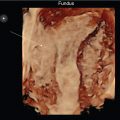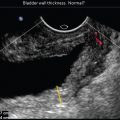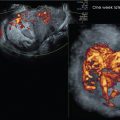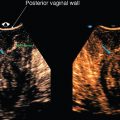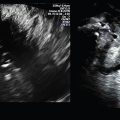Outline
Topic 4, Figure 120
- 1.
Fig. 120 Topic: Basic 3D Instrumentation

Fig. 120
Multiplanar views, in this case of the uterus (labeled A, B or C at the image center; gold arrow), represent the three orthogonal planes surrounding a center reference point (CRP) within a 3D volume set. A is the acquisition sweep plane, B is perpendicular to the A plane at the CRP (white arrow), and C is coronal to the A plane at the CRP. On the A plane, the curved green line of reference (LOR) can be brought to an area of interest as if looking from above into the anatomy below the LOR. This can be changed by the examiner to approach the area of interest from any direction. The volume set can also be manipulated post exam at a workstation.
The “A” plane, seen at the upper left quadrant of the 3D volume set image, is the acquisition plane determined by the examiner. In the middle of the image is a CRP that demonstrates the center of the volume area of interest (white dot; white arrow).
The “B” plane is a vertical cut 90 degrees (perpendicular) to the CRP of plane A and is seen on the upper right quadrant of the 3D volume set image. In the middle of the image is the CRP that demonstrates the center of the volume area of interest (red dot; white arrow).
The “C” plane is a horizontal (coronal) cut 90 degrees to the CRP of plane A and is seen on the lower left quadrant of the 3D volume set image. In the middle of the image is a CRP that demonstrates the center of the volume area of interest (light blue dot; white arrow).
The bottom right quadrant is the location for the 3D rendered image, which is determined by the operator using various instrumentation tools, especially the LOR.
Since the 3D volume exists, any “slice” of the anatomy can be pulled out of context by parallel shifting through the volume set; therefore, it can be post-processed at a workstation. By appropriate placement of the above settings, the uterus can be seen in the sagittal, transverse, and coronal planes with an upright 3D rendered image.
Case 56, Figure 121
- 2.
Fig. 121 is a transperineal midsagittal image of the urethra at rest using a 5–9 MHz transducer. The top of the screen is inferior and screen left is anterior. The urethra is measured from the mid-bladder/urethral neck interface to the most distal visualized urethral mucosa. If it cannot be measured in one line, another can be measured and added to the first, as is seen on Fig. 121 .
- a.
What is the urethral length of this patient? _____
- b.
On this image, each line-to-line distance measures 1cm. What is the urethral anteroposterior (AP) neck measurement (yellow line)? _____
- c.
To what is the gold arrow pointing? _____

Fig. 121
- a.
Case 57, Figure 122
- 3.
Fig. 122 is a transperineal midsagittal image of the urethra at rest (A) using a 5–9 MHz endovaginal (EV) transducer and at maximum cough stopped from a cine loop (B). It demonstrates the greatest posterior movement of the urethra on this patient with minimal but reduced size in neck AP diameter (gold arrow). Using the calipers on a frozen image allows post-exam measurements of any structure. What does the AP urethral bladder neck measure at maximum cough? _____

Fig. 122
Case 58, Figure 123
- 4.
Fig. 123 demonstrates a normal midsagittal urethra using a 5–9 MHz EV transducer at the perineum where a manual trace measurement calculates the urethral length. If the ultrasound system has this capability, it is the most useful in measuring curved structures such as the urethra.
- a.
Is the length normal? _____
- b.
Is the focal zone setting (white arrow) at an appropriate level to demonstrate the urethral neck? _____

Fig. 123
- a.
Case 59, Figure 124
- 5.
Fig. 124 is an image of the normal internal anal sphincter (IAS) using a 6–12 MHz EV transducer placed perpendicularly at the posterior vaginal wall in a transverse plane. At what level is the cut—proximal, mid, or distal? _____

Fig. 124
- 6.
Is the posterior vaginal wall imaged? _____
- 7.
At what anatomic structure is the focal zone indicator placed along the side of the image?
- a.
Vaginal wall
- b.
Puborectalis aspect of the pubovisceralis muscle (PVM) complex
- c.
Lateral aspect of the PVM complex
- d.
Central mucosa of the IAS
- a.
Case 60, Figure 125
- 8.
Fig. 125 is performed to assess the intrauterine device (IUD) location. Screen left includes the uterine C plane taken out of a 3D volume set and rotated upright on the Z-axis. Which of the levels on the sagittal image (screen right) is the correct plane depicted on the C plane—1 or 2? _____

Fig. 125
Case 61, Figures 126–128
- 9.
Figs. 126–128 represent a case illustrating how correct use of the line of reference (LOR) in a 3D volume set can help to solve an issue that is otherwise nearly impossible in 2D imaging alone. Fig. 126 is a transabdominal 3D volume set done in search of a lost IUD with a concomitant 29 weeks 1d gestational age (GA) intrauterine pregnancy (IUP). Though this is a gyn case series, utilization of 3D imaging to find a lost IUD, with or without a coexisting pregnancy, is a challenge the gyn imaging specialist will likely encounter.

Fig. 126
The patient was not experiencing any discomfort, but a previous first-trimester exam suggested its location at the lower uterine segment (LUS). Once the IUD location was suspected as remaining present within the LUS on 2D imaging, the 3D volume set was performed to confirm the IUD location relative to the fetus.
The CRP placement (red arrows, Fig. 126 ) is near the edge of, but not on , the IUD and is seen at all three orthogonal planes. In fact, the only quadrant where the IUD is clearly seen is the left lower quadrant C plane, but its relationship to the fetus cannot be seen. Notice that the 3D LOR (curved green line) is above the IUD area of interest (too high) on A and B planes, making the (screen lower right) rendered 3D image of Fig. 126 useless by including all the anatomy from the CRP level to the LOR.
What is the distance from the IUD to the edge of the fetal head, even though it globally appears “directly adjacent?” _____
In Fig. 127 , by bringing the CRP to the IUD and the green LOR down to just above the IUD on A and B planes, the directly adjacent IUD location relative to the fetal head (gold arrow) is now recognizable within the medial wall of the myometrium. Fig. 128 is the 3D rendered IUD rotated upright using the Z-axis knob, but it is the volume set that reveals the relative structures.

Fig. 127

Fig. 128
Case 62, Figures 129–131
- 10.
Figs. 129–131 demonstrate transperineal transverse images of the anal sphincter complex (ASC) using a 6–12 MHz EV transducer on a patient in a great deal of pain following a history of a traumatic vaginal delivery. In these cases, the transperineal exam requires an extremely delicate touch with minimum pressure of the transducer placement on the perineum.
Normally, the transducer in a transverse position, placed at the posterior vaginal wall and angled inferiorly to superiorly, depicts the ASC near the transducer on the screen with the posterior vaginal wall appearing homogeneous and only a few millimeters in thickness. Little pressure of the transducer is needed.
In this case, the transducer contact pressure was reduced even more to demonstrate true perianal postpartum trauma swelling.
Fig. 129 . Using calipers on the side of the first image, what is the distance from the transducer to the rectum in this case (red arrow to red arrow)? _____

Fig. 129
- 11.
Fig. 129 is at a different ASC level than Fig. 130 , though both images are transverse cuts. Though the IAS is not ideally seen in either image, it is because emphasis for these images was placed on demonstration of the superficial abnormal perianal tissue.
- a.
Which image demonstrates the external anal sphincter (EAS) level— Fig. 129 or Fig. 130 ? _____
- b.
Which image demonstrates the PVM complex— Fig. 129 or Fig. 130 ? _____

Fig. 130
- a.
- 12.
With Figs. 129 and 130 , both on Fig. 131 , describe the perianal tissue (measured by red arrows) between the transducer and the rectum using appropriate sonographic descriptive nomenclature.
- a.
Shape _____
- b.
Size _____
- c.
Echo pattern _____
- d.
Color Power Doppler pattern _____

Fig. 131
- a.
Case 63, Figures 132–134
- 13.
Figs. 132–134 represent the 3D ultrasound exam that was performed on a patient who was thought to have expelled her IUD and subsequently had another inserted. Following placement of the second IUD, she began experiencing deep pelvic pain.
- a.
Fig. 132 . Does the 3D volume set demonstrate an IUD stem within the central cavity? _____
- b.
Is the green line of reference on the A plane of the 3D volume set placed correctly to most optimally visualize the stem on the rendered image? _____
- c.
Of note, however, is that the 3D rendered image ( Fig. 132 , bottom right of the volume set) demonstrates an additional abnormal hyperechoic structure at the lower uterine segment (LUS; green arrow). On which side of the patient is the green arrowed structure? _____
- a.


